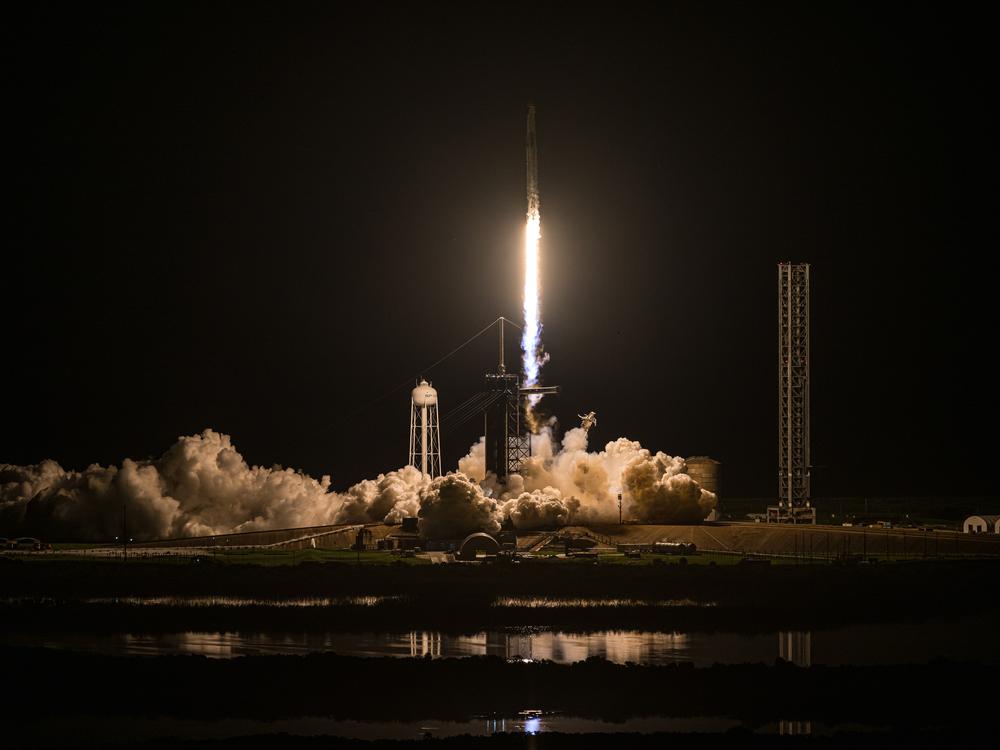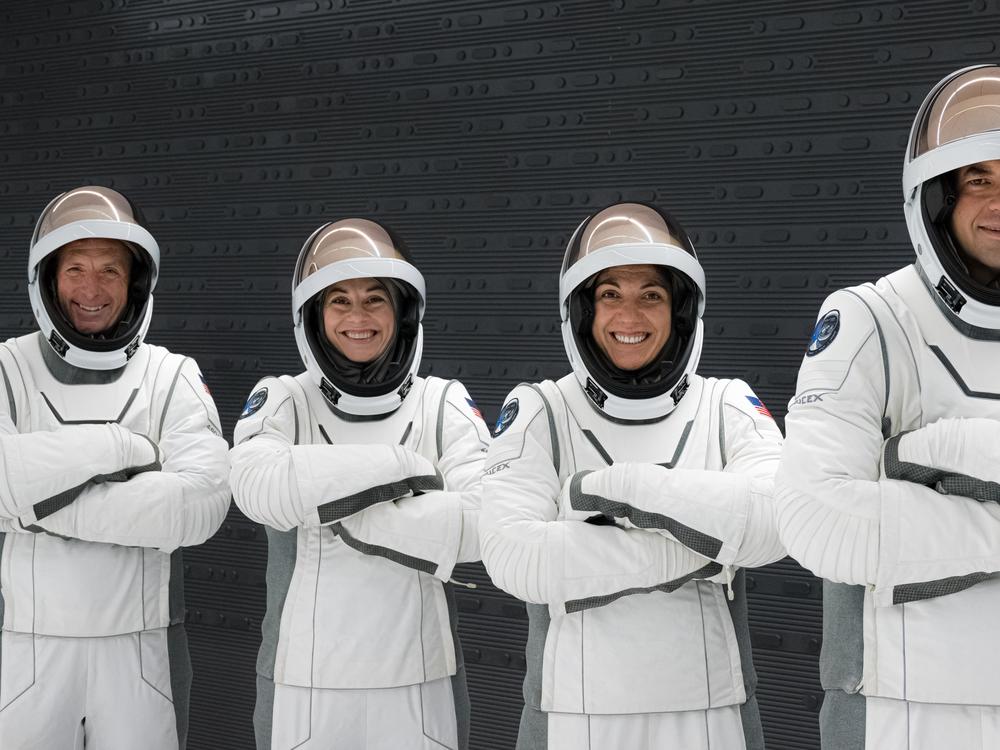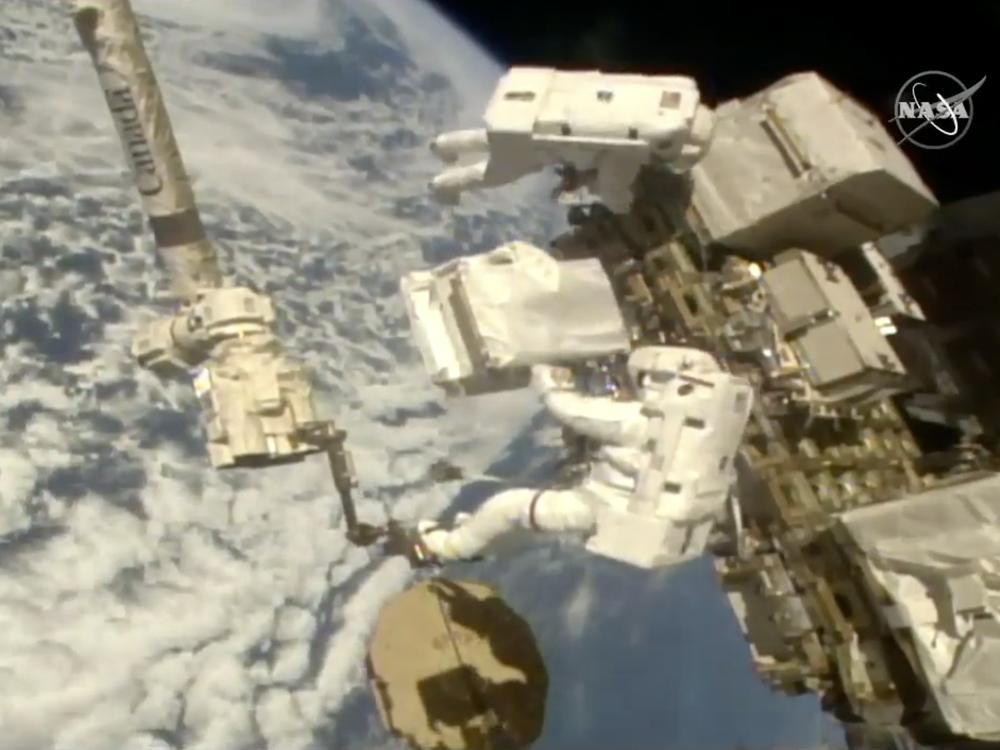Section Branding
Header Content
The Polaris Dawn spacewalk is SpaceX’s ‘risky adventure’
Primary Content
A SpaceX rocket lifted off early Tuesday morning carrying four astronauts who hope to conduct the world’s first commercial spacewalk. The launch from the Kennedy Space Center in Florida marks the beginning of one of SpaceX’s highest-stakes missions yet.
If all goes as expected, in a matter of days, Internet entrepreneur Jared Isaacman and SpaceX engineer Sarah Gillis will be the first private astronauts to exit their spacecraft to float above the Earth in spacesuits. They’ll be treated to a majestic view of the planet that’s only been seen by professional astronauts working on official missions from their space agencies.
But experts warn there’s plenty that could go wrong. Spacewalking carries unique risks compared to traveling inside a capsule or visiting the International Space Station. This mission will use several components that have never been tested in space before, including the spacesuits themselves. And it will require skill and cool-headed thinking from the astronauts involved, three of whom have never been to space at all.
Conducting a spacewalk like this is a “risky adventure,” acknowledges Bill Gerstenmaier, SpaceX’s vice president of build and flight reliability, who previously headed NASA’s human spaceflight operations.
But he insists that the company is ready: “We’re going to do it as safely as we can, and we’ve got the right protocols and we’ve done the right testing to get ready to go,” Gerstenmaier told reporters at a press briefing last month.
A giant leap, for a price
The mission, known as Polaris Dawn, is a giant leap for commercial space travel. To date, most space tourists have either taken a brief suborbital journey that provides a few moments of weightlessness, or (for significantly more money) traveled to the International Space Station. Isaacman spent a few days in 2021 orbiting earth in a SpaceX capsule.
He’s now paid an undisclosed sum of money for this mission, which is the first of three scheduled as part of the Polaris program. Isaacman had floated the idea of the second mission being used to service the Hubble Space telescope, but NASA recently said the agency would not pursue it at this time because they’re not sure it’s worth the risks.
On this mission, all four astronauts will don new SpaceX spacesuits before purging the air from their Dragon capsule. Isaacman, the mission commander, and Gillis will then open the hatch and float briefly out of the capsule, connected by umbilical cords that will supply them with oxygen. The mission’s pilot, Scott Poteet, and medical officer and SpaceX employee Anna Menon will remain inside the capsule.
The allure of doing a spacewalk is clear. The view is stunning, says Luca Parmitano, an astronaut for the European Space Agency who has conducted six spacewalks.
“It’s almost as if time stops for a second, or your heart stops for a second, it’s just so beautiful,” he says.
But Parmitano says that spacewalking is also physically and mentally challenging. The suits are pressurized, making them stiff and inflexible.
"At one point during the spacewalk, you’re going to be hot, you’re going to be cold, your hands are going to hurt,” he says. “You have to embrace the suck.”
And there’s a lot that can go wrong. During a spacewalk outside the International Space Station in 2013, Parmitano’s helmet began filling with water from his spacesuit’s cooling system. In zero G, the capillary pressure caused the water to stick to his skin and begin creeping around his head.
“It covered my eyes, it covered my ears, it went inside my nose,” Parmitano recalls. He was unable to communicate because his radio no longer worked. “I was on my own, isolated. I couldn’t see anything, I couldn’t hear, I couldn’t talk.”
Heating up
Spacewalks (known in the business as Extravehicular Activities, or EVAs), have always been among the most dangerous parts of space travel. During the first American spacewalks carried out during the Gemini program of the 1960s, crew members frequently experienced problems with their suits, according to Emily Margolis, a curator of contemporary spaceflight at the Smithsonian National Air and Space Museum.
“Of the nine EVAs that took place during project Gemini, three of them actually ended early due to concerns over health and safety,” Margolis says.
For example on Gemini 9, astronaut Gene Cernan was supposed to test a kind of rocket pack to help astronauts move around in space. His suit included a metallic coating to protect him from the exhaust of the rocket pack, but the coating made it far harder to move.
One of the paradoxes of spacewalking is that, although space is cold, the lack of atmosphere around the suit can actually cause heat to build up inside. As Cernan struggled to move, he ended up overexerting himself.
“He started to sweat profusely and the moisture in the suit started to fog his vizor,” Margolis says. With his visibility severely impaired, his crewmate cut the EVA short and brought him back inside.
When Cernan returned to Earth, Margolis says, it was determined he’d lost 13 pounds over the mission. “It’s believed that most of that was water weight from the amount that he was sweating during this EVA,” she says.
Spacewalks have become more routine since then, but they remain risky, according to Jonathan Clark, a physician at Baylor College of Medicine who has consulted for both NASA and SpaceX on spacesuits. By his count, around one in five spacewalks encounter some sort of problem.
“Sometimes you can adapt to it, but a lot of times you’ve got to stop the EVA and come back in,” he says.
In the case of Luca Parmitano, the astronaut whose helmet began filling with water, he had little choice but to cut the spacewalk short. Because he couldn’t see, he had to work his way back to the airlock from memory. Eventually fellow spacewalker Chris Cassidy helped him get back inside and close the hatch.
“I don’t take any specific credit for keeping my cool because I’d been trained my whole adult life to perform in relatively risky situations,” says Parmitano, who is also a colonel and test pilot in the Italian Air Force.
New challenges
Clark notes that the Polaris Dawn crew has had far less experience. Of the four crewmembers, only Isaacman has actually been to space.
Beyond that, “none of the crew has done an actual spacewalk before,” he says. “It’s going to be a first for everybody.”
The crew will be wearing new SpaceX suits that in some ways resemble those worn by earlier generations of astronauts. They will be fed oxygen by an umbilical cord connected to the spacecraft, and the suits themselves will be passively cooled with air from the umbilical. That means there’s no chance of a water leak, like what happened to Parmitano, but overheating similar to the Gemini missions could become an issue, as could fogging of the astronaut’s visors.
Moreover, the Dragon Capsule itself will have to continue to operate smoothly under vacuum. Without air circulating, the capsule’s onboard computers will have a harder time keeping cool.
“The challenges are certainly there,” Clark says.
But newbies can do tough things in space. Sian Proctor was the pilot of Isaacman’s first mission to orbit the earth in 2021. Until six months before launch, she’d never flown a rocket.
“I basically went from being a geoscience professor to being a mission pilot of a spacecraft,” she says.
Proctor says SpaceX got her ready. In fact, Sarah Gillis helped train her for her mission. Another member of this latest crew, Scott Poteet, was the mission director for her launch.
While Proctor’s brief flight took only six months to prepare for, this latest mission has been in the works for more than two years, allowing for much more training.
Proctor says, If anyone can carry out the first commercial spacewalk, it’s this team.
“The crew is amazing,” she says. “They are so competent at what they do.”



